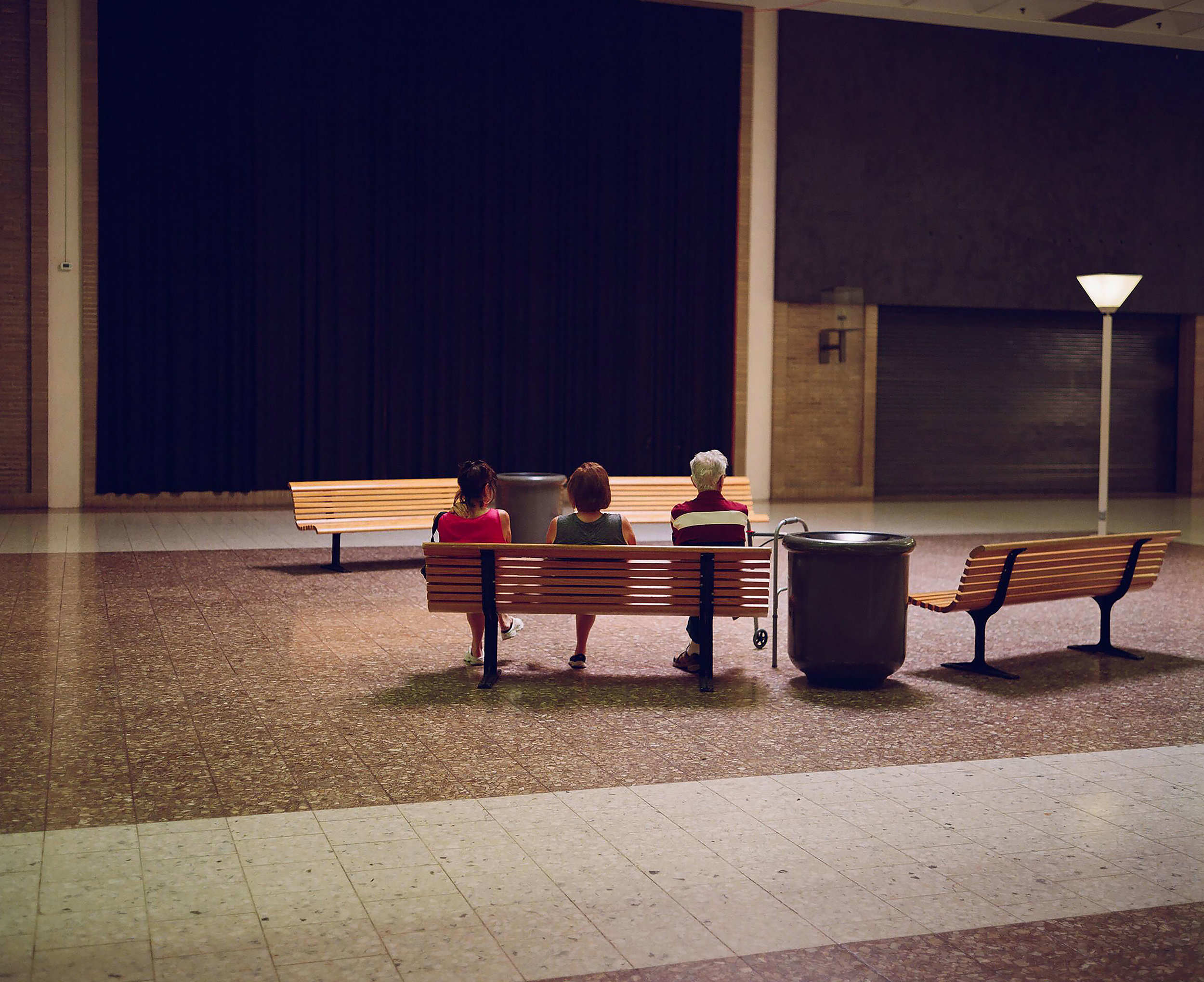Photographer Phil Donohue on Invisible Spaces
Interview by Mathea Millman
I first encountered Phil's work on Instagram where I fell in love with his aesthetic and unique point of view. When I was curating the first zine for Antihero, 'On Vulnerability', I came across an image of his that was perfect for the project and he allowed me to use the image. After that, we kept in touch and eventually he mentioned to me that he was interested in publishing a book of his photography. So I went through his archive and curated this book while bringing Sarah Bachman on to design the beautiful cover. In finality, the project came to fruition as, 'I dreamed it was better than it was'.
This book is simultaneously an ode to the shopping malls, cultural centers and physical structures that Phil grew up around and also a critique of the fact that some of our most precious memories are so deeply rooted in commerce. That we have more feelings associated with a store, than we sometimes do our fellow man. The book is available to order online through Antihero Press.
Mathea Millman: Hey Phil. I know you didn’t start shooting the pictures in this book as a specific project, so how did you start shooting these images? What did you start shooting and why?
Phil Donohue: Well I’m a child of the 80’s. I was born in ‘83, so I grew up with film. It’s what I always shot on. I was always either filming or photographing things, I always had a kind of distancing object. But I really started shooting this type of work around 2006.
I grew up in the suburbs of Phoenix and everything was new to an extent. It was kind of like a sleepy desert town, there wasn’t a lot going on. And when the 90’s came, it was just a lot of development and cookie cutter homes, Best Buy’s and Chili’s. My mom had me when she was sixteen, so I grew up in a space where a 1980’s teenage girl would hang out. Those were the places I was around as a kid, so most of my youth was spent in a retail space, department stores and going into the racks. To this day places like Esprit are kind of embedded in my memory as feelings. The spaces created a sense of transportation—a sense of an alternate reality in a place that was very kind of basic.
Mathea: So the spaces you photograph are familiar to you?
Phil: Yeah, but they also stood out because they were designed and there was some sort of thought behind them. But also, as I grew older, I was obsessed with the feelings associated with those spaces and why I held onto them so dearly. The design had a way of luring people in. And now the spaces don’t have to lure anyone. They can just sell people the shit they want and they don’t have to make the physical retail experience interesting anymore.
Mathea: So how much of what you’re shooting are you interested in architecturally and how much is exploring a sense of nostalgia? Or are they completely intertwined?
Phil: They’re completely intertwined. I’ll go on a trip and I’ll shoot everything. I look at it sort of like a jazz song or something. I have some notes I know I want to hit but usually I’m just meandering and I’ll allow myself to go whatever direction I’m taken in. I feel like I’m in a different space now because I plan more. Whereas toward the beginning it was all organic and I would just drive and shoot what I encountered. Now I’m much more research based. The Rust Belt trip was heavily researched and thought out.
Mathea: Are there certain qualities you’re looking for or is it more about hitting an emotional point for you?
Phil: I felt like film was going away and these spaces were going away and the only way to capture these things in a way in which they would be honored was to just do it myself.
Mathea: So some of this nostalgia is about trying to capture a way of life that just isn’t quite so prevalent anymore?
Phil: I was genuinely nostalgic for these things. I view art as therapy in a lot of ways and a lot of the things that I ended up working out through this work was that I attached way too much feeling to spaces. Why was I attaching so much feeling to commerce? I think part of my work now attempts to challenge my own nostalgia. What nostalgia really is and what the present day context of it is.
Mathea: You were shooting these spaces because they had triggered something in you that led to some sort of deep feeling and connection to the past that you were trying to connect to.
Phil: A lot of people say my work is ‘sad’.
Mathea: Well, yeah. You’re shooting these abandoned places that I see almost like a movie. You can almost see the people who are no longer in the spaces like ghosts. So many people grew up going to these places to hang with friends and go on dates and be social and now there’s one person checking their iPhone.
Phil: 100%. These are kind of like forgotten spaces and a lot of these people tend to be alone in these spaces and I think a forgotten space or a forgotten person is something that is tough for me for some reason. In some ways I’m saying “I see you, you matter, these spaces matter, the world we live in matters.” You’ll notice there aren’t many couples or people together in my images and when they are together they also seem alone.
Mathea: Like the one with the three people in the mall on the bench. And no one is talking to each other or they are just looking at their phones
Phil: People rip millennials for always being on their phones but people accomplish a lot on their phones. I look at this photograph and I wonder if people would be better off with a phone and I guess my ambivalence towards that is part of maybe what makes it interesting.
Mathea: No one is connecting.
Phil: Look at the space between them. That’s just how it is.
Mathea: Can you talk about this hotel interior?
Phil: That was shot at the Hotel Del Coronado n Coronado Island in San Diego. And I think that guy has been there the whole time. I’m not kidding. He’s known to be fairly cantankerous and to me he represents a time long past. He has worked his whole life as an elevator operator.
Mathea: Do you know that?
Phil: Yeah. I’ve looked into it and he’s been there forever—as long as I’ve been going there he’s been there.
Mathea: Did you ever talk to him?
Phil: No, he’s very cantankerous and very much about doing his thing.
Mathea: Did he know you were taking his picture?
Phil: No. Almost no one knows I’m taking their photo.
Mathea: Because even though there are people in those spaces you’re not taking their portraits.
Phil: No. The portrait is of the spaces and these are the people who inhabit the spaces. I think that because I work in film, I’m not interested in directing or giving context or posing anyone. I really want these things to be genuine. These are all genuine moments. Nothing is contrived other than the fact that I’m putting a frame around it. These things aren’t staged. I don’t interfere in any way.
Mathea: Even the interior at the restaurant with no one there I would describe as sad even though there is this spotlight kind of metaphorically shining down.
Phil: You really love this image.
Mathea: Yeah I do. It just seems like there’s this spotlight on an empty scene and to me that really represents the rest of the body of work almost. Spotlight on a forgotten time or place even. Everyone is somewhere else in their minds.
Phil: There are a lot of these types of restaurants throughout LA on the hills with really large banquet halls and the food is subpar and costs a lot. But I like to go up there sometimes and get some view shots and pop in because it just has this dated feel.
Mathea: What about this space?
Phil: This is the Bonaventure Hotel. This is wild. So there’s an exact replica of this maybe about two floors down and they don’t have the exercise machines there anymore but it used to be a running track or still is a running track but each of these pods had an exercise machine on them. So you could run the track and do a couple of pumps and then continue to the next exercise machine. But this is one of my favorite spaces in Los Angeles and one of my most widely disseminated images.
Mathea: Well there’s just something that’s captured here with the concrete structures and how it’s supposed to be inviting with these pods meant for people to be in and it just ends up giving off the opposite effect by singling everyone out and isolating them.
Phil: And everyone comes here on their lunch break to sit, alone, and to be on their phone and to relax. And there are not that many cozy spaces in Los Angeles where you can be by yourself and sit and be completely by yourself. I mean you are on display in these spots but no one else is looking.
Mathea: So they become invisible. These are invisible spaces
Phil: In a lot of ways I think so, yeah.
Keep up with Phil and Antihero Press.







